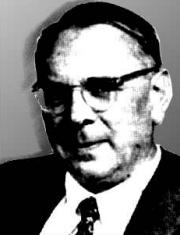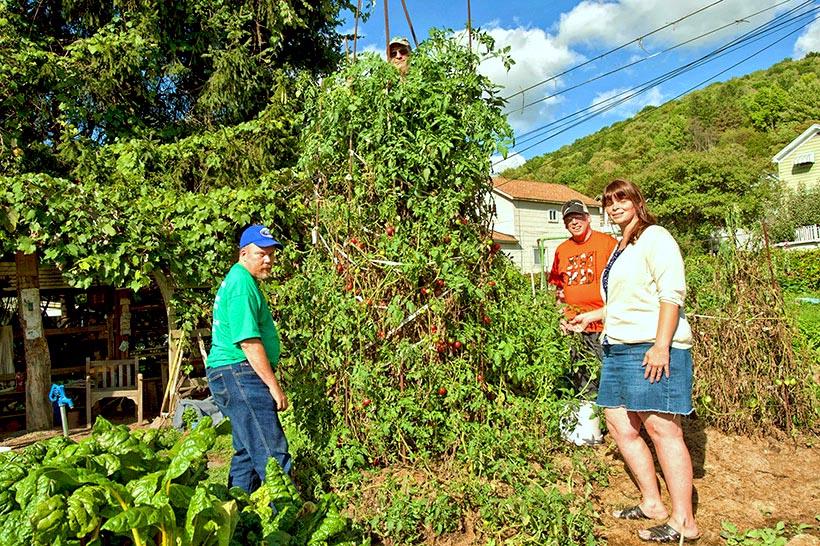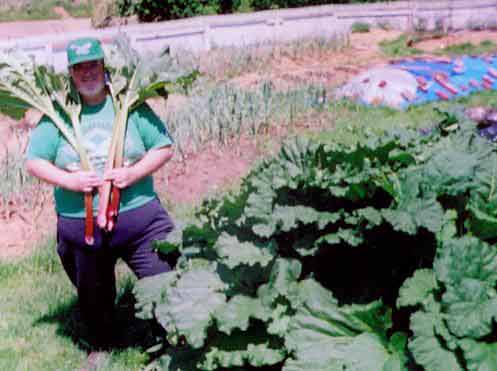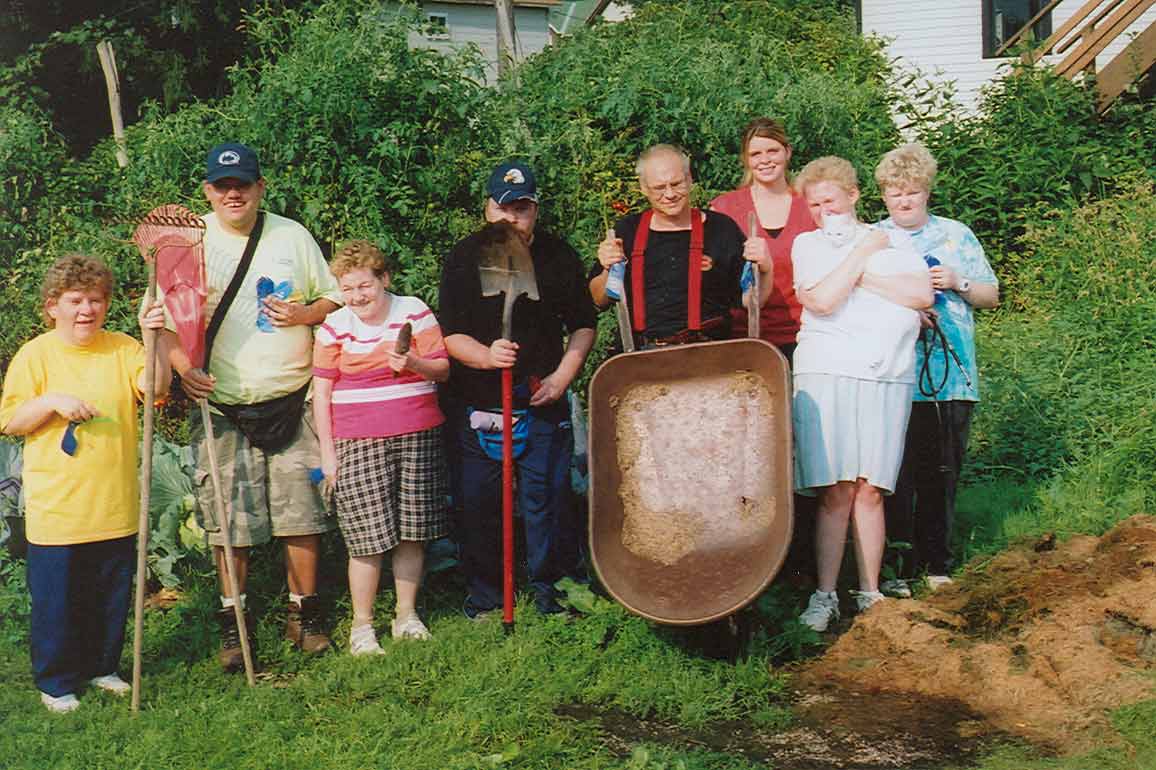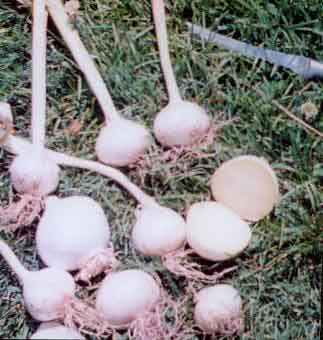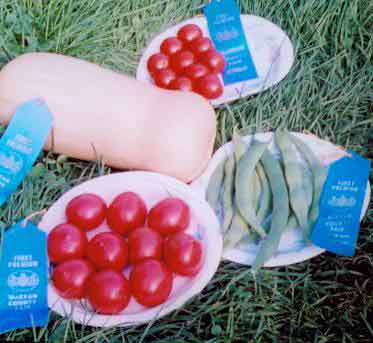 | ||
|
|
||
|
|
|||
|
|||
Evergreen Elm's Biodynamic Cherry Tomato Plant
|
|||
One morning in October, 1950, two strangers walked into the office of Tony Dalcino, president of the Oakland Scavenger Company, with a proposition that turned Dalcino's casual smile into a look of utter disbelief.
His callers wanted to know whether the company would let them have part of the daily haul of garbage it collects from the city of Oakland, California. They hoped, they said, to put the garbage on an assembly line and sell it!
Garbage was one thing Dalcino had plenty of. His company picks up about 400 tons a day from Oakland, and he was sitting right in the middle of it, so to speak, for his plant is built on a peninsula of garbage fill that yearly bites deeper into San Francisco Bay, eight miles from the city.
That his lowly stock in trade could achieve any more useful end than in the shallow waters of the bay was a thought which fascihated Dalcino but left him understandably skeptical. With notable restraint, he asked to hear more.
The two visitors were a combination nearly as strange as the idea they were proposing. One of them was Richard Stovroff, young owner of a wastepaper business in Buffalo, New York. The other was Dr. Ehrenfried E. Pfeiffer, German-born biochemist, holder of an honorary U.S. medical degree, and lifelong experimenter with new ways to grow better food.
Pfeiffer, a tall, robust, pink-cheeked man with an infectious twinkle, explained. In the course of his researches he had discovered a new race of bacteria which could convert garbage into fertilizer, a sweet-smelling black earth which could perform virtual miracles for the land. A tablespoon of the bacteria, grown in test tubes, could turn a ton of garbage into rich humus in three weeks.
Pfeiffer told Dalcino: It costs Americans, as taxpayers, a few billion dollars a year when we throw away as garbage the precious minerals and organic material which we take out of the soil in the form of food: On the other hand, it costs farmers nearly $7,000,000,000 a year to put some of these minerals back in the ground in the form of chemical fertilizers. That doesn't make sense. He had, he added, decided to do something about it ever since his arrival in the U.S. in 1940 as a refugee from war-ravaged Europe.
Today, as a result of Pfeiffer's exposition nearly two years ago, nobody in Oakland, least of all the Oakland Scavengers, finds anything odd in the business of converting garbage. On the edge of San Francisco Bay, in a small, slate-gray building which serves as pilot plant for the Pfeiffer project, as many as 100 tons of wilted refuse a day are fed into one end of a system of conveyer belts. It comes out the other end as compost, ready, after a brief layover, to be shipped to farms and nurseries all over the nation.
Already, this spring, home gardeners in the West have had a chance to conduct their own tests on it; the Ferry-Morse Seed Company has distributed it and is using it to cultivate its own prize grass and flower seeds in Salinas, California.
In addition, many of the fresh vegetables now on your dinner table from the Salinas Valley Salad Bowl owe an extra charge of vitamins and minerals to this onetime Oakland garbage. A doubting foreman of one of the big Salinas farms which use the compost took a bag of it home recently, dumped it on his lawn and forgot about it. Weeks after the summer drought began, his neighbors became curious; his was the only lawn in town whose grass was still lush and green.
In control tests at Pfeiffer's Biochemical Research Laboratory at Spring Valley, New York, vegetables grown in this converted garbage have weighed 25 per cent more than those grown in conventional fertilizers, with from one to three times more vitamin A. The garbage-compost-treated soil has shown from one to four times as much life-giving nitrogen, and grain grown in it has shown a consistently higher protein content.
Laboratory experiments have proved that the mixture can restore even sterile sand to vigorous fertility and could make rich farm land out of desert if adequate water were available.
What the converted garbage does to the soil is to restore its organic matter, mineral balance and structure; it gives the soil body, and permits it to absorb and hold water. In the soil, this organic
matter releases a powerful concentration of bacteria whose digestive activities and decay create plant foods and soil-binding humus, release nitrogen and make more efficient use of chemical fertilizers.
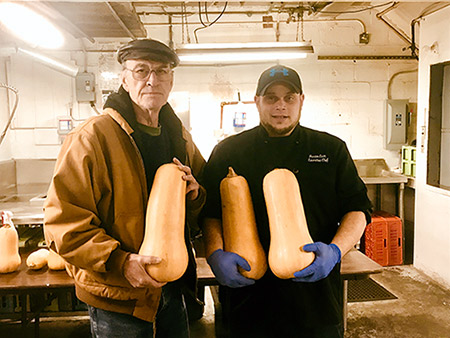
L.A. Rotheraine, Biodynamic Master Gardener with Jordan Evan, Executive
Chef
at the Penn Hills Club, show Biodynamic Butternut Squash.
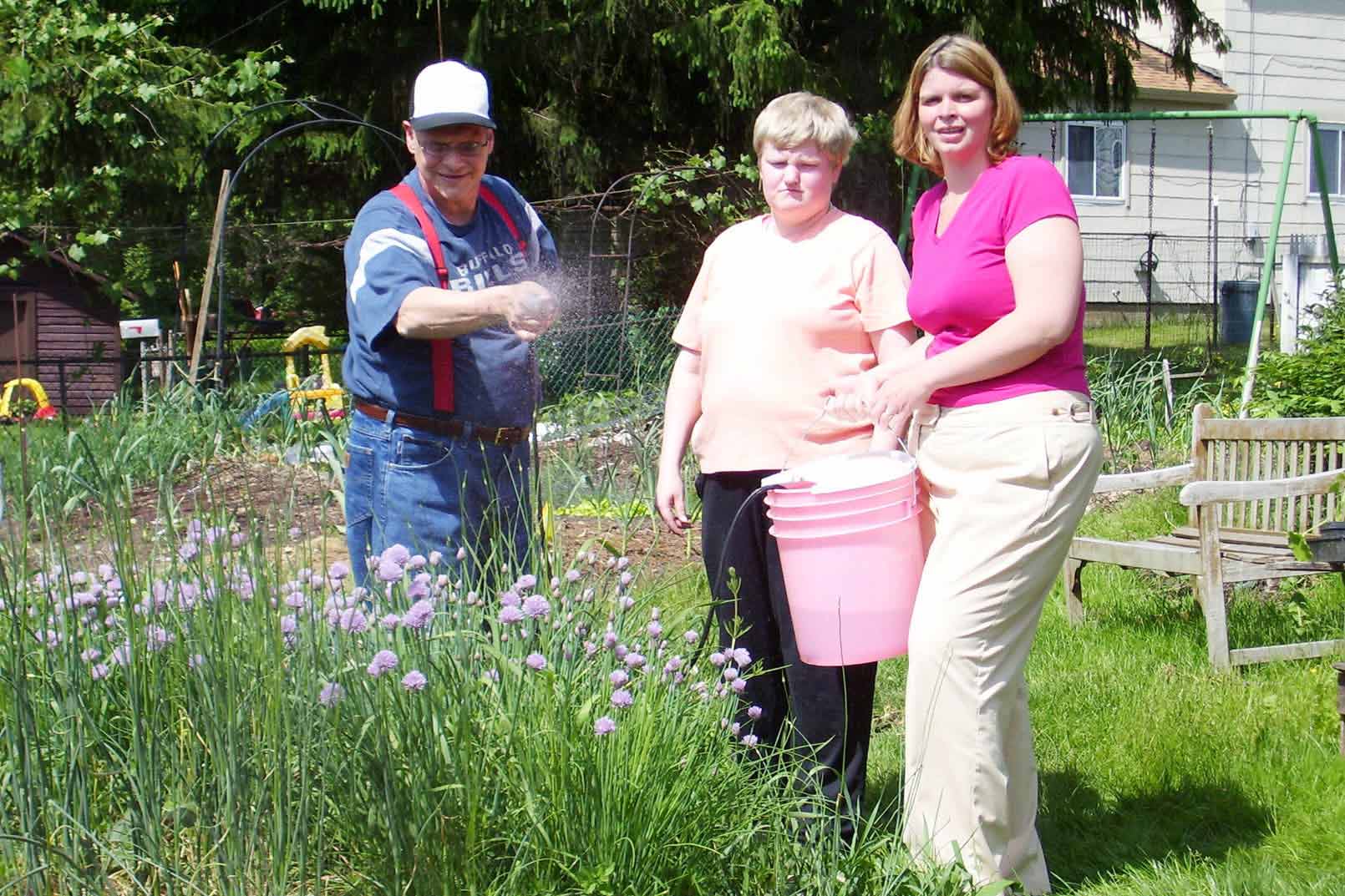
Era photo by TAMMARRAH MILES
Mike Rowley with biodynamic rhubarb at Elm Street garden.
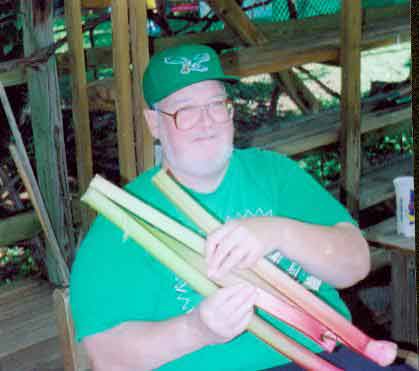
Mike Rowley with same biodynamic rhubarb after it has been dressed.
LA Rotheraine and his Biodynamic Ratatouille Tomato which he
developed with the aid of Pfeiffer's Biodynamic Compost Starter ( now made by Hugh J. Courtney).
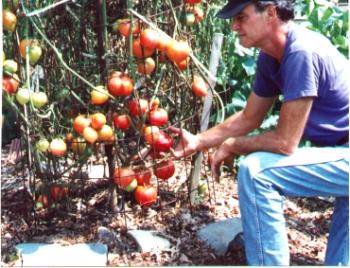
rotheraine's organic tomatoes
Rotheraine.com
Chemical Fertilizers Less Efficient
Chemical fertilizers return plant food directly to the soil but do not provide this vital organic soil structure (although the new chemical, Krilium, by making the soil more porous, will increase the efficiency of organic fertilizers). All farmers try to restore it in part by growing cover crops and plowing them under, or by turning under plant stubble.
The converted-garbage fertilizer is actually a scientifically produced supercompost, a little like the material conscientious gardeners make by piling up leaves, vegetable matter and manure and allowing them to age. Such composting takes six to nine months and a great deal of care, but farmers regard the resulting product as black gold. It is the stuff that gives virgin soil its loamy, crumbly appearance.
However, compost is a luxury fertilizer. You can't buy it in commercial quantities or at prices practical for mass-production farming. Neither can the mass-production farmer make it. At today's pace, he has neither the time nor man power. He also lacks the materials, the ready supply of manure and vegetable matter which diversified farms once had.
The Oakland plant hopes to provide the answer to this nation-wide need for a cheap supply of natural organic matter. The gradual depletion of our soil's organic reserves, and the attempt to make up for it solely by increasing the use of chemicals, has long worried agriculturists. Without any organic matter to anchor the topsoil, farm lands can become dust bowls.
No one plant can do this job,Pfeiffer points out, but if all U.S. garbage were processed each year, we would have about 30,000,000 tons of compost, enough to fertilize 10,000,000 acres of land. And garbage dumps would just about disappear.
He sees the Oakland project as a showcase, not only for farmers, but also for cities seeking a solution for the problem of garbage disposal. The Oakland compost now costs $34 a ton, but Pfeiffer expects even this price, comparable to conventional fertilizer costs, to go down as production expands. Since January the plant has been converting 100 to 125 tons of garbage a day, and expects to produce a minimum of 60,000 tons of compost during the corming year.
Oakland, meanwhile, likes the showcase idea and is intrigued by its curious distinction as the first city in the world to turn garbage into a useful commercial product.
Tribune Points with Pride
Oakland, let us announce with pride, is the Compost City of America, the Oakland Tribune recently boasted. The paper went on to chide San Francisco for not getting a compost plant, too.
California does have its backward cities, it commented. Walter F. Gibson, head of Oakland's sanitation department, has called the plant a boon to any municipality, as it disposes of the garbage problem. It is economically sound and can be operated in any area.
No such rosy optimism existed in the fall of 1950, when the plant began operations under the resounding name of Compost Corporation of America. Seven stockholders - mainly paper processors who saw a promise of a new pulp supply from the garbage - were persuaded to spend a total of $150,000 to start the company, which is known in Oakland as Comco. Richard Stovroff, the Buffalo businessman, was named president. Stock on hand included an unlimited supply of garbage and several test tubes filled with hungry bacteria.
For 30 years, Oakland's garbage has been collected under contract with the city by the Scavengers, 250 Italian-Americans who function as a co-operative, sharing titles, profits and labor equally. The friendly if skeptical Scavengers turned over to Comco some of their 30 garbage-built acres for a plant; they offered the garbage for nothing.
Young Dick Stovroff was skeptical himself, but the prospect of getting a profitable supply of wastepaper from the conveyer- belt handling of rubbish convinced him. As it turned out, that paper amounted to only about one per cent of the plant's $50,000 income last year.
Pfeiffer's arrival at Oakland's garbage dumps came about by way of the widest possible detour - one which included several European countries and a period on what seemed at the time to be his deathbed.
Born in Munich fifty-three years ago, Pfeiffer as a boy emigrated with his parents to Switzerland, where he became a naturalized citizen. He graduated with honors from the University of Basel and was on his way to a doctorate when a significant event occurred. Strolling on the streets of Basel one winter day, he noticed that the frost patterns on windowpanes differed from shop to shop.
What eventually developed out of his walk that day was a revolutionary method of diagnosing human disease by means of the crystal or frost patterns made from a drop of the patient's blood crystallized, together with chloride of copper, on a glass plate. These crystal patterns distinguish a healthy person from a sick one and they have proved 82 per cent reliable in the diagnosis of cancer. In 1939 the crystallization theory was to bring Pfeiffer an honorary doctorate from Hahnemann Hospital and Medical College in Philadelphia.
While pursuing his crystallization studies, he was appointed director of the Biochemical Research Laboratory at Dornach, Switzerland, and manager and director of an 800-acre experimental farm at Loverendale, Holland. The farm, set up to carry out some of the agricultural studies of the laboratory, fed 700 families. For years, Pfeiffer commuted monthly between Holland and Switzerland. Then, in 1940, the Nazis smashed through Holland, and Pfeiffer, his wife, son and daughter took to the road as refugees.
They traveled across southern France and crossed into Spain by way of the Pyrenees, and flew from there into Portugal. On an October day in 1940, they arrived in New York with a few bags and $50 in cash.
For the next few years, the scientist managed and helped develop a model experimental farm at Phoenixville, Pennsylvania, on a former private estate where prize tomatoes were grown in winter in what had once been a palatial solarium. Then he bought his own farm near Chester, New York. What he got for the modest amount of cash he could raise was a primitive farmhouse, 260 stony acres and a herd of 40 cattle, which, it soon developed, were riddled with the dread Bang's disease.
This was the kind of challenge Pfeiffer liked. It gave him a chance to test his soil theories at the dirt farmer level. You can't prove anything with a farm that's subsidized and loaded with gadgets that the average farmer can't afford, he says.
Within two years he had restored's land with scientific composts, fed the grain grown on it to his cattle and completely cured them without medication. They cured themselves, he recalls. We just provided the proper nutrition and care.
The astonishing little bacteria which are now the secret of converting garbage to a humus concentrate at Oakland indirectly saved Pfeiffer's life. In 1944 the strain of 16-hour days divided between science and farming proved too great. Pfeiffer collapsed one night over his worktable, At New York State's Summit Park Sanatorium he got the grim word that he was in an advanced stage of tuberculosis. The chances of recovery, even with surgery, were slim.
Pfeiffer spent more than a year in bed at the sanatorium, reading and staring at the ceiling, and doing more thinking than he had ever before had time for. I figured out that in order to stay alive in such a crisis a man has to find himself a tough job that is just too important to be left unfinished, and then plunge into it and let the doctors do the rest. For Pfeiffer, the job was the search for his bacteria formula.
He knew by the statistics that the organic humus content of U.S. soil is decreasing to the danger level. Yet there was a treasure of organic matter in many waste products like garbage if a swift method of converting them could be found. There was one important clue. In Europe, farmers for centuries have used various wild plants like nettle, dandelion and valerian to produce a quicker breakdown and stabilizing of manures and composts. Did the secret lie in some bacteria which such plants breed?
When Pfeiffer was able to get out of his bed, he headed straight for the sanatorium's bacteriological laboratory. There, watching the action of tubercular bacteria under a microscope, he forgot his illness. He studied bacterial specimens from digestive tracts and noted how these germs actually broke down and digested waste material.
The clue he found in digestive tracts was that 25 to 30 per cent of the mass was bacteria. The bacteria digest and break down food, and would go on breaking it down until nothing was left, except that other bacteria take over and convert what remains into minerals and proteins needed by the body. Wild nettle and such plants contain hormones which cause a similar action to take place in the soil.
What Pfeiffer was looking for was a breed of bacteria he could isolate and control, to perform this kind of job on waste materials at the greatest possible speed.
A year after he began his research, he walked out of the sanatorium completely recovered; his case was regarded as something of a miracle. When he left, be had with him the formula he sought. To put it to work, he opened his own laboratory over a rented garage. That laboratory has now grown into a spacious building set in the peaceful woodlands of Spring Valley.
Today one section of the laboratory exhibits the results of this work. The walls are lined with shelves of test tubes and beakers filled with black earth made from nearly every kind of waste product imaginable - nutshells, human feces, cotton waste, sugarcane stalks, even sheep's wool and human hair - and of course garbage.
It takes more than 50 different carefully bred strains of bacteria, each with its own digestive job, to transform any one of these materials. Each strain is kept isolated because it is cultured only on that material which encourages its greatest growth in nature. Materials which might stimulate the growth of foreign bacteria are kept out of its food. Then the different bacterial strains are painstakingly blended together.
Each composted material must have its own special blend. Summer garbage, for example, wouldn't tempt a bacteria family that lives off winter garbage. Given the right food and temperatures, the bacteria will live indefinitely in their test tubes.
The bacteria are temperamental, and harder to manage than a trained flea circus. You can see the fleas, but can you imagine telling one microbe from another? smiles Pfeiffer. Sometimes one of them will go on a hunger strike and die, and when one gets lost there's the devil to pay. One species got away from us recently; we thought we had lost it for good, but we found it later in a compost pile in Oakland.
The bacteria are harmless to humans and animals, but will decompose just about anything else. Not long ago, an improperly packed test tube broke inside of a bag on its way to Oakland. The busy bacteria had digested most of the bag and were sampling the wrappings before the accident was discovered.
Sally Burns, a pretty, twenty-five year-old ex-Wave, deserves a share of the credit for getting the Oakland experiment under way. Sally, now Comco's lab technician, was a research assistant at the Pfeiffer laboratory when the bacteria starter was developed. Sally was fired by Pfeiffer's enthusiasm. When she returned to her home in suburban Buffalo, she went to local newspaper editors and got them to print the story of the bacteria discovery. She floored friends with long monologues on garbage.
But her campaign got results. One day Pfeiffer was asked to go to Buffalo to deliver a radio talk. While there, he met Richard Stovroff, who proposed that they go into business. The scientist refused any financial interest in the new company, but agreed to supply the bacteria starter and donate his time in getting production under way. Oakland was selected as the site because of its proximity to the big California truck farms, and also because of its warm climate, which makes bacteria act faster.
Winners Again in August '07 Fair Competion
Bradford Journal Photo
|
Uncloved, solid head elephant garlic grows from regular elephant garlic cloves in the Elm Street Garden! |
Pfeiffer's Thrilling Moment
Recently Pfeiffer flew to Oakland to have a look at his brain child. Although he derives no personal profit from Comco (his laboratory in New York gets a small royally for the use of the bacteria), the scientist behaved like a man just awarded an extra bonus. For on that day, he was informed, Comco was handling a quarter of Oakland's daily garbage - about 100 tons.
As Pfeiffer watched, lines of heavily laden garbage trucks rumbled down to the foot of Davis Street, which stops almost at the edge of San Francisco Bay. Jouncing across the refuse-strewn yard, the trucks dumped their aromatic loads. Tractor plows nosed it into the piles and pushed them into a long trough leading into the Comco plant.
In the trough was a three-foot-wide conveyer belt. As it hit the belt, the garbage began to move into the world's only garbage assembly plant - or, to be absolutely correct, disassembly plant, because the garbage is taken apart rather than put together, as Pfeiffer will remind you.
The first thing the garbage encountered in the operation inside the plant was a pair of giant suction fans which hang over the belt. Acting like outsize vacuum cleaners, the fans picked off most of the wastepaper as the garbage sailed by. Later this paper would go to pulp companies.
Pfeiffer followed the mixture as it ascended on the belt to the second floor. Occasionally he ran an experienced hand through it. You can read the seasons by what people put in their trash pails, he told a visitor. in summer, you get a lot of green vegetables and fewer meat scraps. Just after Christmas, the supply of broken toys and empty paper boxes is heavy. Even an occasional gift tie goes by. Then in spring come the half-used bottles of vitamin tablets and tonics. We are grateful for the vitamin pills, he smiled. What we are trying to do is get them back into the food.
Except for the gamy scent, the atmosphere on the second floor of the building was like any small manufacturing plant. A crew of 10 workers bent over the belt. As the garbage marched past, they rummaged around in it with gloved hands, pulling out glass or wooden objects, plus whatever metal had been missed by the huge magnet that scans the refuse. These items were dropped into appropriate chutes.
When Comco began operations, the sorting problem seemed a big hurdle to overcome. Pfeiffer recalled: We wondered whether we would be able to find people willing to keep their hands in garbage all day long. But we found all the help we needed. Garbage can become as inoffensive as any other product in time.
Properly picked over, the garbage next dropped through a chute and was carted by waiting trucks to a second conveyer some distance from the plant. This conveyer sent it riding up to the top of a roofed platform, 10 feet off the ground, for the most critical part of the operation.
Two things happen to the mixture when it reaches the platform. First it is chewed up, somewhat the way meat is in a meat grinder. Then it is soaked under a shower.
When Pfeiffer clambered up to the top of the platform on this particular morning, he peered anxiously into a big iron hopper four feet across. Steel blades, each a foot long, were churning around against stationary knives in the hopper. As the garbage rode in, it was pulverized.
This part of the operation nearly put Comco out of business at the start because of trouble with the big grinding blades. Steel is tough, but "soft" garbage can be even tougher. The garbage would chew foot-long blades down to a nub in three days. After weeks of desperate experimenting, Comco abandoned commercial grinders and designed one of its own. A tougher steel was found and the blade pitch was changed. That did the trick.
A steady stream of water poured down on the mixture as it churned through the hopper. It was water spiked with bacteria about a tablespoon for every ton of garbage. The action of the bacteria is immediate. An hour after the moistened garbage is spewed off the rear of the platform and stacked in heaps, a change begins to take place. Within two to four days the bacteria will multiply themselves 300,000,000 times. The action is so intense that the mixture heats up to more than 150 degrees and becomes almost too hot to handle.
How the Bacteria Go to Work
The mountainous piles present a weird spectacle on the San Francisco Bay landscape. For days, these heaps actually cook, throwing off dense clouds of steam. The furiously multiplying bacteria decompose and digest the garbage, creating enzymes which speed up the digestive process and make possible chemical changes; they act like the starter in your car, getting the engine going. In this case, the engine is the breakdown of elements and subsequent build-up of chemicals in the garbage.
In less than a week, as the decomposition is completed, the piles shrink in size and cool off. But during the digestive period, new, food-building bacteria have begun to grow. Their function, as in the life process itself, is to use the decomposed matter to build living organic matter, store up nutrients in their mass to be used by growing plants, and change basic elements so they can be absorbed into plant roots.
Such bacteria life is present in virgin soil, but in the garbage compost the concentration is several hundred times greater. After the first week of violent decomposition, the garbage has ceased to be rotting material and has become a stabilized plant food. it has no odor; actually, it repels vermin and carrion birds, which hover around the piles but will not venture on them.
Thus, less than three weeks after an Oakland housewife scrapes clean her dinner plates, her garbage is ready to go back into the land as fertilizer.
Despite its pungent atmosphere, the Comco plant has become the showcase Pfeiffer dreamed of. Visitors include officials of cities with a sanitation problem (60 visited the plant in one day recently), university groups, and just plain farmers. One recent visitor was Lady Eve Balfour, organizing secretary of Soil Association, Ltd., a British agricultural group. Lady Eve climbed gingerly around the hillocks of garbage, and later, in an interview, singled out the Comco plant as the high spot of her U.S. tour.
Love that gal, bubbled the Oakland Tribune, editorially.
Since the bacteria starter will make compost of just about anything from peanut shells to sawdust, there appears no limit to its possibilities. One new application for it was suggested by a Comco visitor, a farmer, who saw in the bacteria a new way of speeding the decomposition of cover crops and crop stubble which farmers plow under to return organic matter to the soil.
Today, in Salinas, the Atwood Crop Dusting Service, which specializes in spraying insecticides by plane, buzzes with curious coded telephone messages. Okay. Fly on the bacs in number 75, says a voice at the other end of the line. Within an hour a little hedgehopping plane zooms in over a farmer's field, leaving a spray of hungry bacteria on the crops. Bacs is what Salinas farmers have dubbed Pfeiffer's bacteria. More than 2,000 acres of their land are now being treated this way, and orders are in for spraying another 5,000 acres.
Two ounces of bacs in five gallons of water will treat a whole acre and the total cost is $5.50. Result: the cover crop or the stubble turns to fertilizer so fast the farmer saves a month in starting a new crop.
If this new use for Pfeiffera bacteria seems to steal a little of the show from the plant-made compost, the scientist is not the least bit disappointed. His hope is to get more natural fertilization into the land by any means possible, and his trained bacteria are not particular where they live, so long as the food is good.
In Florida and Texas, water hyacinths have begun to choke the pond and lake waters, making them unnavigable. A Texas farmer, Alexander Debruille, now harvests the hyacinths, composts them with "bacs" and gets five to 10 tons of rich plant food a day. A national dairy is studying plans for using the "bacs" on cow manure and putting itself into the fertilizer business.
In coming months, Pfeiffer will go to Cuba to set up an experimental plant to convert tons of waste sugar-cane fiber into much needed organic fertilizer in that largely one-crop country.
Another Pfeiffer project now under way is the pilot plant he and his research associate, Peter Escher, have set up deep in the ill-smelling New Jersey meadows across from New York City. A company there makes tallow from beef offal, and the idea was to make compost of the contents of cows paunches. When the scientist arrived home after a day of skidding about on tallow-coated floors, he carried with him an aroma that sent the dogs scattering in the farmyard. Mrs. Pfeiffer made him change his clothes in the barn before he could get into, the house. On the Pfeiffer farm, grain fields and a lush truck garden are fertilized entirely from former garbage. Curiously, there is almost no sign of insects, although no insecticides are used.
Pfeiffer does not find this remarkable. The 800-acre farm which he managed in Holland required neither chemical fertilizers nor insecticides, yet had one of the best dairy herds in Europe. Wheat yields reached 100 bushels an acre, among the highest recorded anywhere in the world. The farm's produce was so nutritious that in a survey the 700 families who lived off it reported they needed only two thirds of what they once ate to satisfy their needs.
Crops That Resist Insects
Pfeiffer credits this to the scientific composts used, which in turn produced healthier, more nutritious crops. Crops grown in a robust soil, are better able to resist insect attacks; an example is the 1,000-acre Malabar Farm of author-farmer Louis Bromfield, which depends largely on composted organic matter and requires no insecticides.
Dr. Firman Bear of Rutgers University, described by the National Fertilizer Association as one of America's outstanding scientists, said recently: . . . (chemical) fertilizers alone, no matter how heavy the rate of application, will not meet the requirements for soils that are producing cultivated. crops. Soil must be fed organic matter in larger amounts than the roots and residues can provide. There is need for study of the possibilities for recovery of city wastes.
Pfeiffer declares that plants which get no organic matter and are fed exclusively on chemicals are somewhat like unhealthy people who grow fat on sugars and sweets. According to research done at the Missouri Agricultural Experimental station, the plants produce an unbalanced amount of carbohydrates (sugar) at the expense of protein and trace minerals. Insects, he says, prefer these sweer plants and are able to attack them more easily. The plants, in turn, provide less nourishment to humans.
Along with all leading agricultural authorities, Pfeiffer emphasizes that insecticides are indispensable to general farming in America: Without insecticides and fertilizers, our farm economy would collapse and our current food production would be impossible. However, the phenomenally increasing need for insecticides is a warning sign of the dangerous deficiencies developing in our croplands, which must in turn affect national health.
To overcome these deficiencies, Pfeiffer wants to see a partnership of chemical fertilizing and organic composts. Both are needed, he says. Both work together.
No man to rest on his laurels, Pfeiffer zestfully welcomes the stream of inquiries which arrive in the mail each day from an increasing number of U.S. cities, and from farther afield as well. A Mexican firm wants to set up a nation-wide composting plant, and farm organizations in Australia and New Zealand have invited him for a demonstration tour there next year.
The busy scientist has accepted the latter invitation, as well as requests from the Indian and Nationalist Chinese governments to visit India and Formosa for what may well be the crowning achievement of an already notable career: to demonstrate how his bacteria can make human fertilizer safe for composting. Such waste matter is now a main source of fertilizer in both countries, but it is also a main source of epidemic infections, because it carries typhus and other germs.
Sanitary human fertilizer, produced by trained bacteria, has already been developed by Pfeiffer in his laboratory. It is exactly like the Oakland compost. Used on a wide scale, it may well save millions of lives in undeveloped countries and change the economic course of history.
Now that's an Organic Tomato Plant!
L.A. Rotheraine (at top of plant), Randy Johnson (middle) and Brandi Buck (right) supervisor, look over the 10 1/2 foot cherry tomato plant. If there is no frost in the near future, the plant could reach 12 to 13 feet tall with over 2,000 tomatoes on it.
The plant was grown at Evergreen Elm's garden on Elm Street and is an open pollinated Selke Biodynamic Cherry Tomato Plant, sprayed with the BD Field and Garden Spray created by Ehrenfried Pfeiffer and now made by Hugh J. Courtney ,
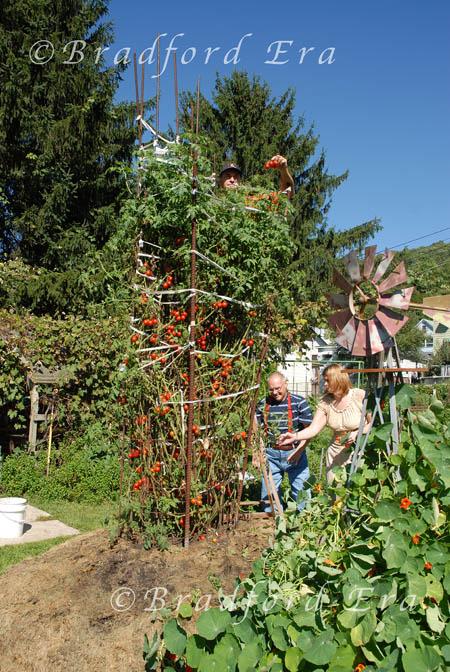
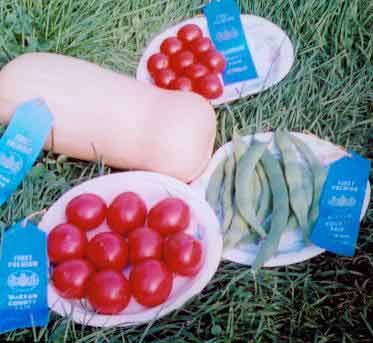 rotheraine's organic tomatoes - grown in old horse manure and garbage-table scraps (all sprayed with the BD Field and Garden Spray created by Ehrenfried Pfeiffer and now made by Hugh J. Courtney. Rotheraine.com |
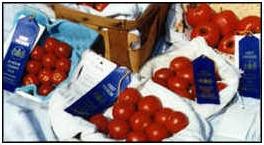 rotheraine's organic tomatoes - grown in old horse manure and garbage- table scraps (all sprayed with the BD Field and Garden Spray created by Ehrenfried Pfeiffer and now made by Hugh J. Courtney. Rotheraine.com |
Reprinted from
Collier's for May 31, 1952
